Social Psychology Lab Report: Men's Behavior and Social Factors
VerifiedAdded on 2023/01/19
|12
|2644
|91
Report
AI Summary
This social psychology lab report examines the impact of various social factors on men's behavior, focusing on masculinity norms and their influence on help-seeking attitudes. The report utilizes correlation techniques and hypothesis testing to analyze the relationships between variables such as toughness, avoidance of femininity, self-reliance, and dominance. Findings reveal a negative correlation between masculinity norms and the willingness to seek help, suggesting that men often prioritize appearing strong and independent. The study explores how restrictive emotionality, negative attitudes toward homosexuality, and the importance of sex also contribute to this dynamic. The analysis indicates that changes in one variable significantly affect others, highlighting the complex interplay of social pressures and individual behavior. The report concludes by emphasizing the importance of understanding these social influences to address men's mental health and well-being. This report is designed to provide students with valuable insights into social psychology concepts and research methods.
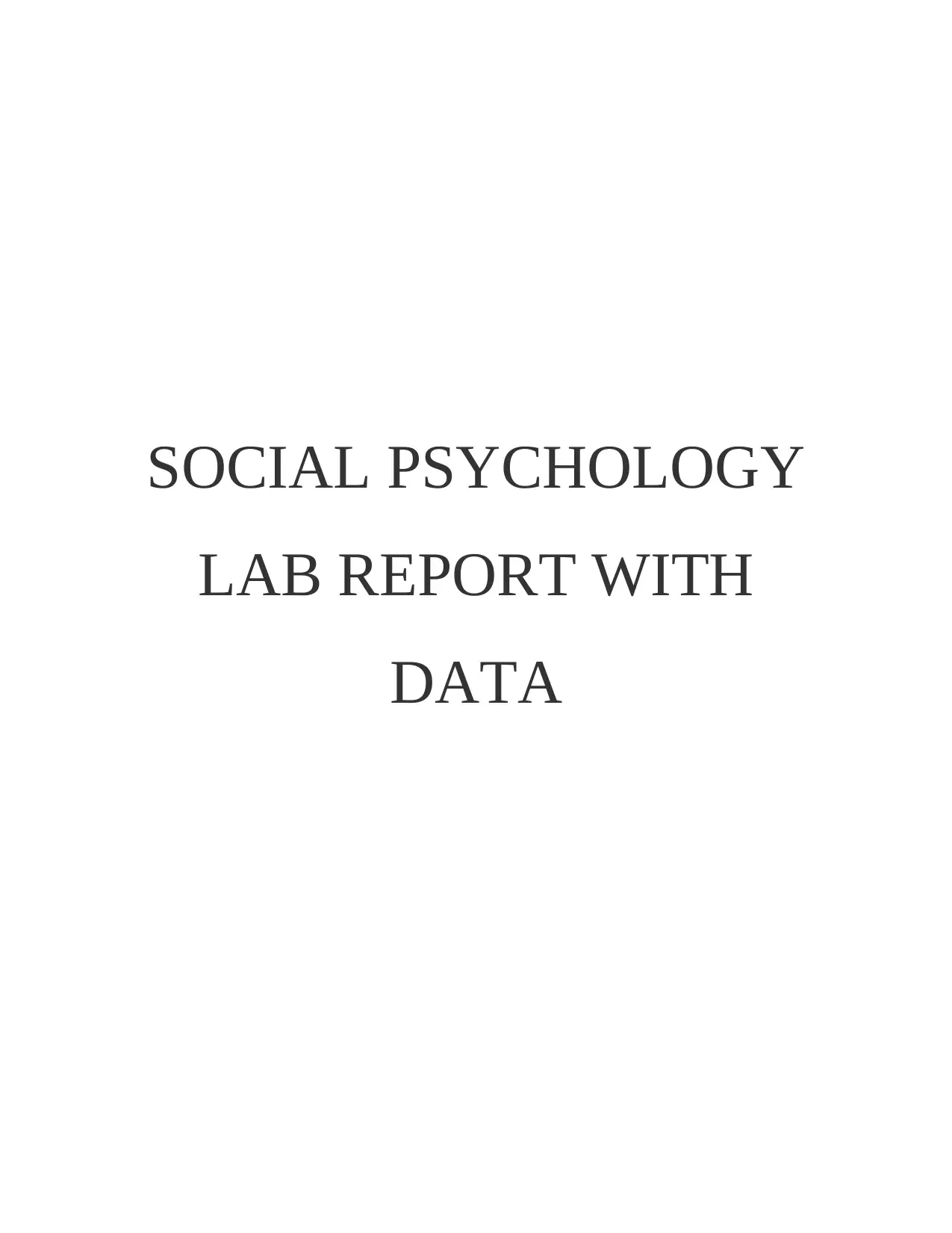
SOCIAL PSYCHOLOGY
LAB REPORT WITH
DATA
LAB REPORT WITH
DATA
Paraphrase This Document
Need a fresh take? Get an instant paraphrase of this document with our AI Paraphraser
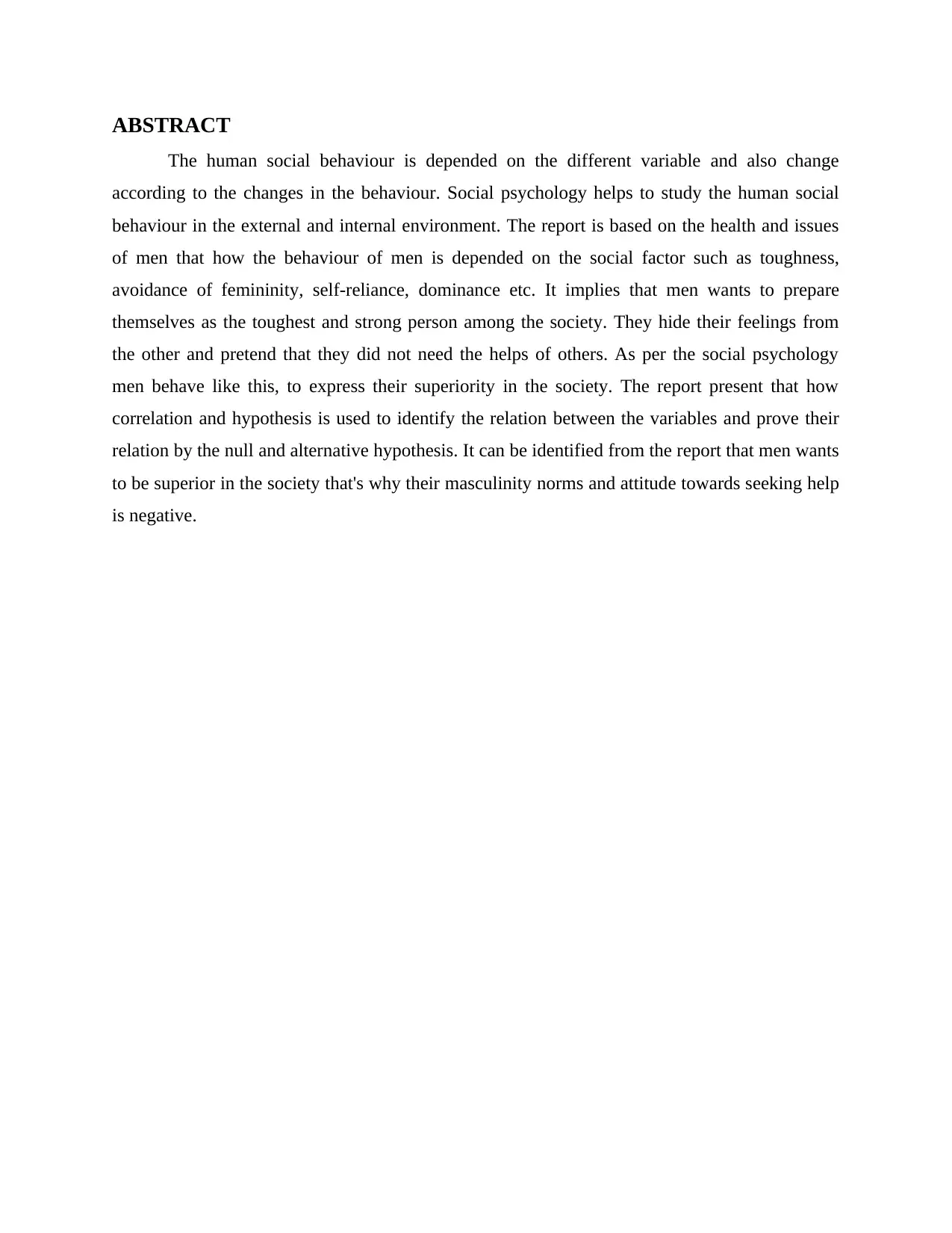
ABSTRACT
The human social behaviour is depended on the different variable and also change
according to the changes in the behaviour. Social psychology helps to study the human social
behaviour in the external and internal environment. The report is based on the health and issues
of men that how the behaviour of men is depended on the social factor such as toughness,
avoidance of femininity, self-reliance, dominance etc. It implies that men wants to prepare
themselves as the toughest and strong person among the society. They hide their feelings from
the other and pretend that they did not need the helps of others. As per the social psychology
men behave like this, to express their superiority in the society. The report present that how
correlation and hypothesis is used to identify the relation between the variables and prove their
relation by the null and alternative hypothesis. It can be identified from the report that men wants
to be superior in the society that's why their masculinity norms and attitude towards seeking help
is negative.
The human social behaviour is depended on the different variable and also change
according to the changes in the behaviour. Social psychology helps to study the human social
behaviour in the external and internal environment. The report is based on the health and issues
of men that how the behaviour of men is depended on the social factor such as toughness,
avoidance of femininity, self-reliance, dominance etc. It implies that men wants to prepare
themselves as the toughest and strong person among the society. They hide their feelings from
the other and pretend that they did not need the helps of others. As per the social psychology
men behave like this, to express their superiority in the society. The report present that how
correlation and hypothesis is used to identify the relation between the variables and prove their
relation by the null and alternative hypothesis. It can be identified from the report that men wants
to be superior in the society that's why their masculinity norms and attitude towards seeking help
is negative.
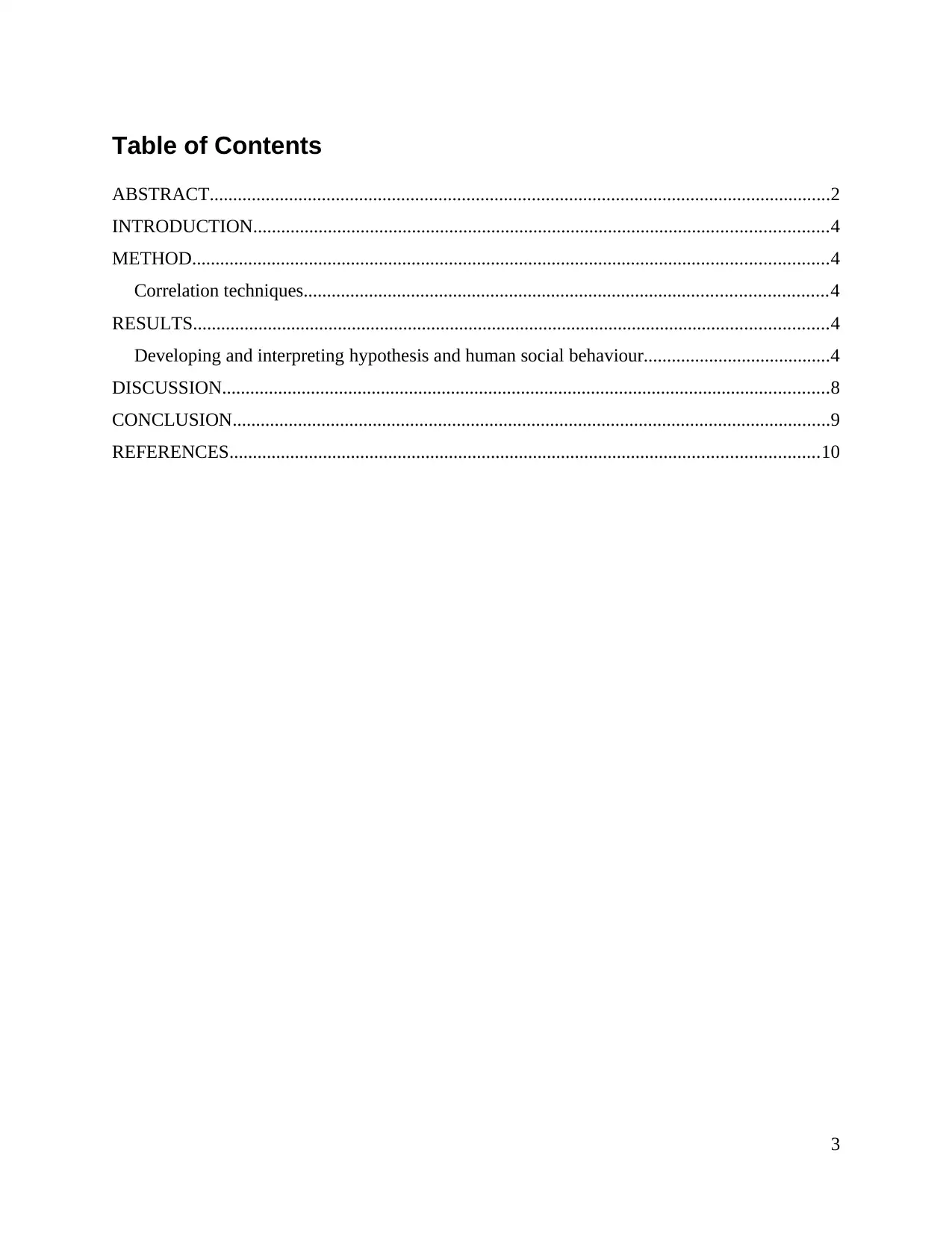
Table of Contents
ABSTRACT.....................................................................................................................................2
INTRODUCTION...........................................................................................................................4
METHOD........................................................................................................................................4
Correlation techniques................................................................................................................4
RESULTS........................................................................................................................................4
Developing and interpreting hypothesis and human social behaviour........................................4
DISCUSSION..................................................................................................................................8
CONCLUSION................................................................................................................................9
REFERENCES..............................................................................................................................10
3
ABSTRACT.....................................................................................................................................2
INTRODUCTION...........................................................................................................................4
METHOD........................................................................................................................................4
Correlation techniques................................................................................................................4
RESULTS........................................................................................................................................4
Developing and interpreting hypothesis and human social behaviour........................................4
DISCUSSION..................................................................................................................................8
CONCLUSION................................................................................................................................9
REFERENCES..............................................................................................................................10
3
⊘ This is a preview!⊘
Do you want full access?
Subscribe today to unlock all pages.

Trusted by 1+ million students worldwide
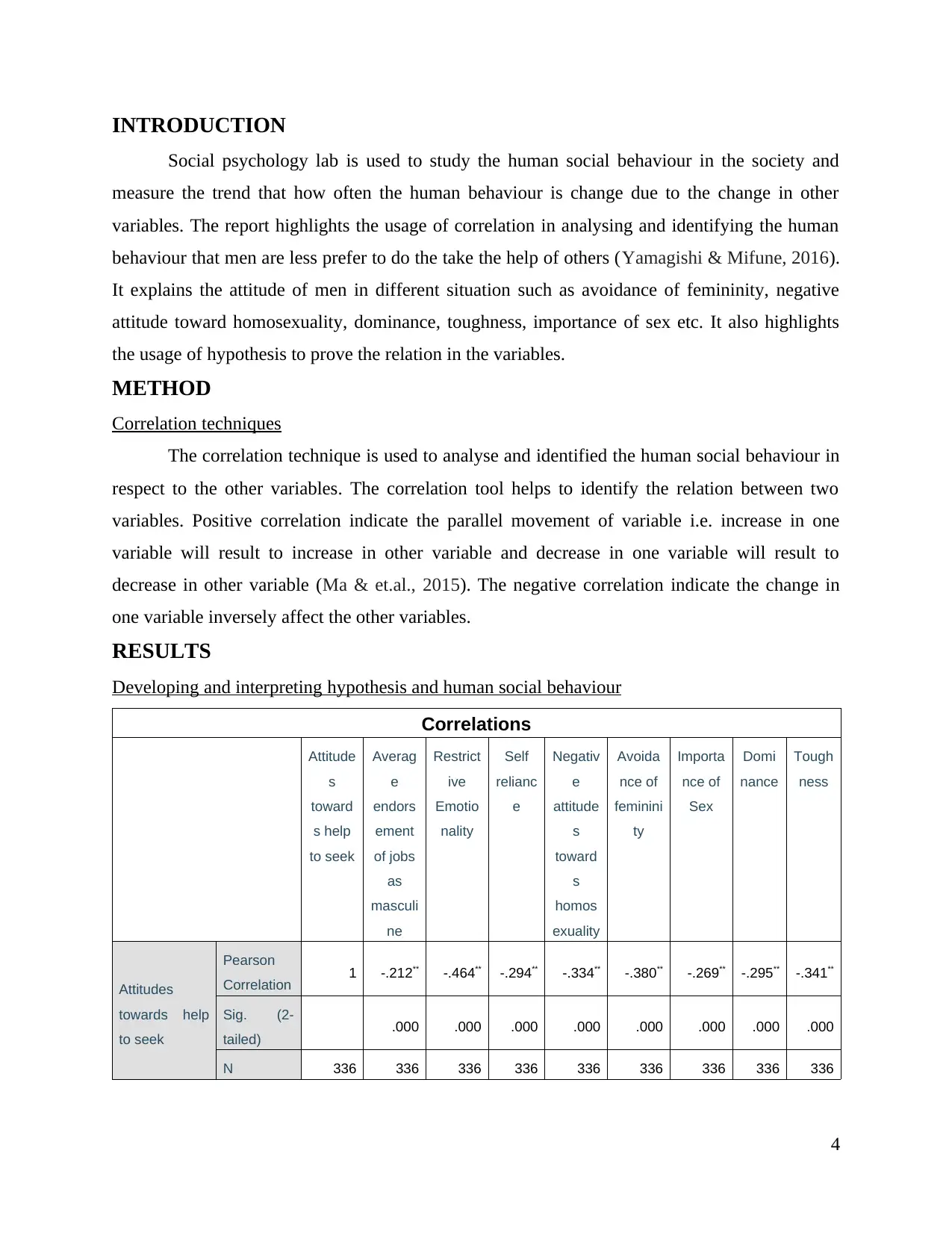
INTRODUCTION
Social psychology lab is used to study the human social behaviour in the society and
measure the trend that how often the human behaviour is change due to the change in other
variables. The report highlights the usage of correlation in analysing and identifying the human
behaviour that men are less prefer to do the take the help of others (Yamagishi & Mifune, 2016).
It explains the attitude of men in different situation such as avoidance of femininity, negative
attitude toward homosexuality, dominance, toughness, importance of sex etc. It also highlights
the usage of hypothesis to prove the relation in the variables.
METHOD
Correlation techniques
The correlation technique is used to analyse and identified the human social behaviour in
respect to the other variables. The correlation tool helps to identify the relation between two
variables. Positive correlation indicate the parallel movement of variable i.e. increase in one
variable will result to increase in other variable and decrease in one variable will result to
decrease in other variable (Ma & et.al., 2015). The negative correlation indicate the change in
one variable inversely affect the other variables.
RESULTS
Developing and interpreting hypothesis and human social behaviour
Correlations
Attitude
s
toward
s help
to seek
Averag
e
endors
ement
of jobs
as
masculi
ne
Restrict
ive
Emotio
nality
Self
relianc
e
Negativ
e
attitude
s
toward
s
homos
exuality
Avoida
nce of
feminini
ty
Importa
nce of
Sex
Domi
nance
Tough
ness
Attitudes
towards help
to seek
Pearson
Correlation 1 -.212** -.464** -.294** -.334** -.380** -.269** -.295** -.341**
Sig. (2-
tailed) .000 .000 .000 .000 .000 .000 .000 .000
N 336 336 336 336 336 336 336 336 336
4
Social psychology lab is used to study the human social behaviour in the society and
measure the trend that how often the human behaviour is change due to the change in other
variables. The report highlights the usage of correlation in analysing and identifying the human
behaviour that men are less prefer to do the take the help of others (Yamagishi & Mifune, 2016).
It explains the attitude of men in different situation such as avoidance of femininity, negative
attitude toward homosexuality, dominance, toughness, importance of sex etc. It also highlights
the usage of hypothesis to prove the relation in the variables.
METHOD
Correlation techniques
The correlation technique is used to analyse and identified the human social behaviour in
respect to the other variables. The correlation tool helps to identify the relation between two
variables. Positive correlation indicate the parallel movement of variable i.e. increase in one
variable will result to increase in other variable and decrease in one variable will result to
decrease in other variable (Ma & et.al., 2015). The negative correlation indicate the change in
one variable inversely affect the other variables.
RESULTS
Developing and interpreting hypothesis and human social behaviour
Correlations
Attitude
s
toward
s help
to seek
Averag
e
endors
ement
of jobs
as
masculi
ne
Restrict
ive
Emotio
nality
Self
relianc
e
Negativ
e
attitude
s
toward
s
homos
exuality
Avoida
nce of
feminini
ty
Importa
nce of
Sex
Domi
nance
Tough
ness
Attitudes
towards help
to seek
Pearson
Correlation 1 -.212** -.464** -.294** -.334** -.380** -.269** -.295** -.341**
Sig. (2-
tailed) .000 .000 .000 .000 .000 .000 .000 .000
N 336 336 336 336 336 336 336 336 336
4
Paraphrase This Document
Need a fresh take? Get an instant paraphrase of this document with our AI Paraphraser
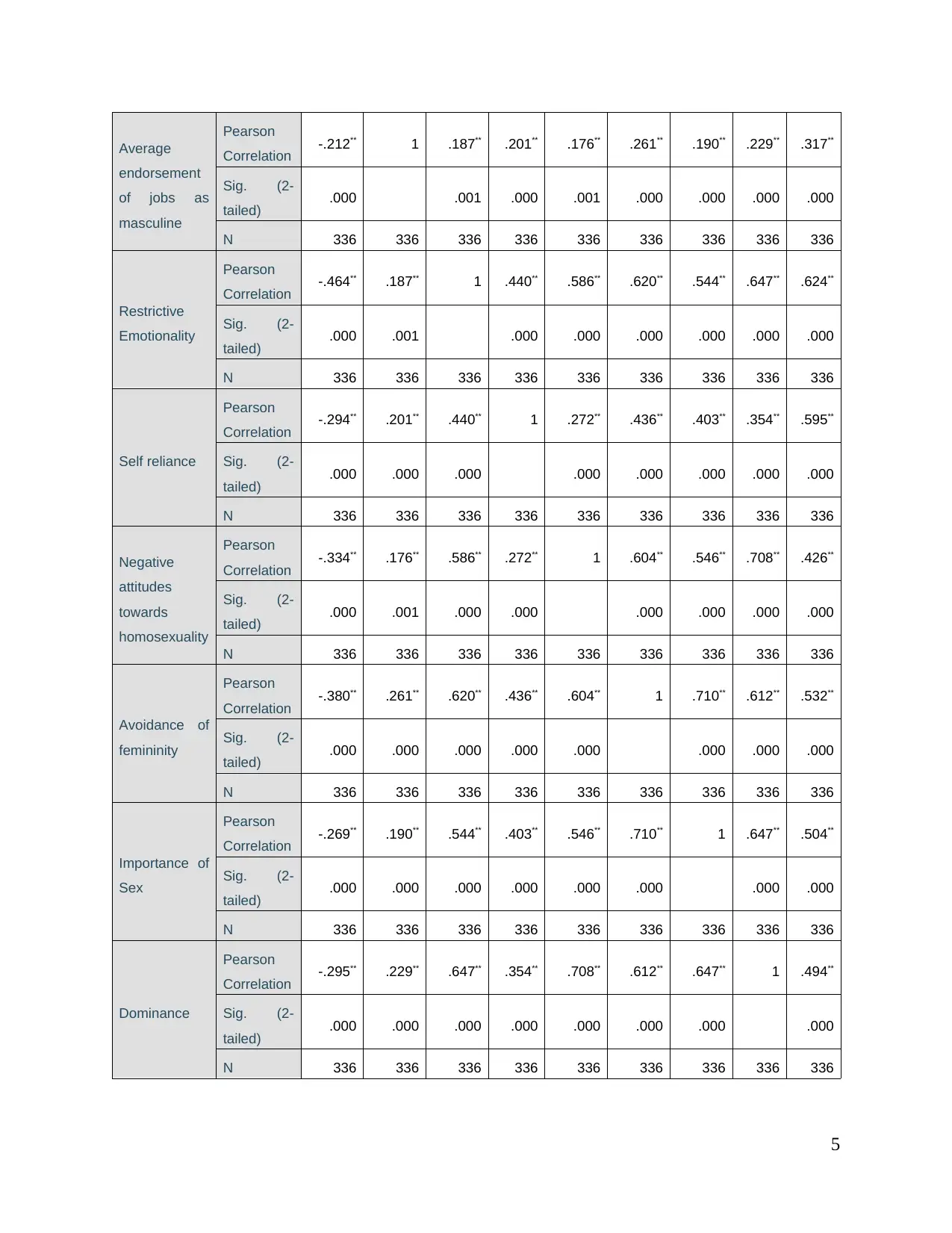
Average
endorsement
of jobs as
masculine
Pearson
Correlation -.212** 1 .187** .201** .176** .261** .190** .229** .317**
Sig. (2-
tailed) .000 .001 .000 .001 .000 .000 .000 .000
N 336 336 336 336 336 336 336 336 336
Restrictive
Emotionality
Pearson
Correlation -.464** .187** 1 .440** .586** .620** .544** .647** .624**
Sig. (2-
tailed) .000 .001 .000 .000 .000 .000 .000 .000
N 336 336 336 336 336 336 336 336 336
Self reliance
Pearson
Correlation -.294** .201** .440** 1 .272** .436** .403** .354** .595**
Sig. (2-
tailed) .000 .000 .000 .000 .000 .000 .000 .000
N 336 336 336 336 336 336 336 336 336
Negative
attitudes
towards
homosexuality
Pearson
Correlation -.334** .176** .586** .272** 1 .604** .546** .708** .426**
Sig. (2-
tailed) .000 .001 .000 .000 .000 .000 .000 .000
N 336 336 336 336 336 336 336 336 336
Avoidance of
femininity
Pearson
Correlation -.380** .261** .620** .436** .604** 1 .710** .612** .532**
Sig. (2-
tailed) .000 .000 .000 .000 .000 .000 .000 .000
N 336 336 336 336 336 336 336 336 336
Importance of
Sex
Pearson
Correlation -.269** .190** .544** .403** .546** .710** 1 .647** .504**
Sig. (2-
tailed) .000 .000 .000 .000 .000 .000 .000 .000
N 336 336 336 336 336 336 336 336 336
Dominance
Pearson
Correlation -.295** .229** .647** .354** .708** .612** .647** 1 .494**
Sig. (2-
tailed) .000 .000 .000 .000 .000 .000 .000 .000
N 336 336 336 336 336 336 336 336 336
5
endorsement
of jobs as
masculine
Pearson
Correlation -.212** 1 .187** .201** .176** .261** .190** .229** .317**
Sig. (2-
tailed) .000 .001 .000 .001 .000 .000 .000 .000
N 336 336 336 336 336 336 336 336 336
Restrictive
Emotionality
Pearson
Correlation -.464** .187** 1 .440** .586** .620** .544** .647** .624**
Sig. (2-
tailed) .000 .001 .000 .000 .000 .000 .000 .000
N 336 336 336 336 336 336 336 336 336
Self reliance
Pearson
Correlation -.294** .201** .440** 1 .272** .436** .403** .354** .595**
Sig. (2-
tailed) .000 .000 .000 .000 .000 .000 .000 .000
N 336 336 336 336 336 336 336 336 336
Negative
attitudes
towards
homosexuality
Pearson
Correlation -.334** .176** .586** .272** 1 .604** .546** .708** .426**
Sig. (2-
tailed) .000 .001 .000 .000 .000 .000 .000 .000
N 336 336 336 336 336 336 336 336 336
Avoidance of
femininity
Pearson
Correlation -.380** .261** .620** .436** .604** 1 .710** .612** .532**
Sig. (2-
tailed) .000 .000 .000 .000 .000 .000 .000 .000
N 336 336 336 336 336 336 336 336 336
Importance of
Sex
Pearson
Correlation -.269** .190** .544** .403** .546** .710** 1 .647** .504**
Sig. (2-
tailed) .000 .000 .000 .000 .000 .000 .000 .000
N 336 336 336 336 336 336 336 336 336
Dominance
Pearson
Correlation -.295** .229** .647** .354** .708** .612** .647** 1 .494**
Sig. (2-
tailed) .000 .000 .000 .000 .000 .000 .000 .000
N 336 336 336 336 336 336 336 336 336
5
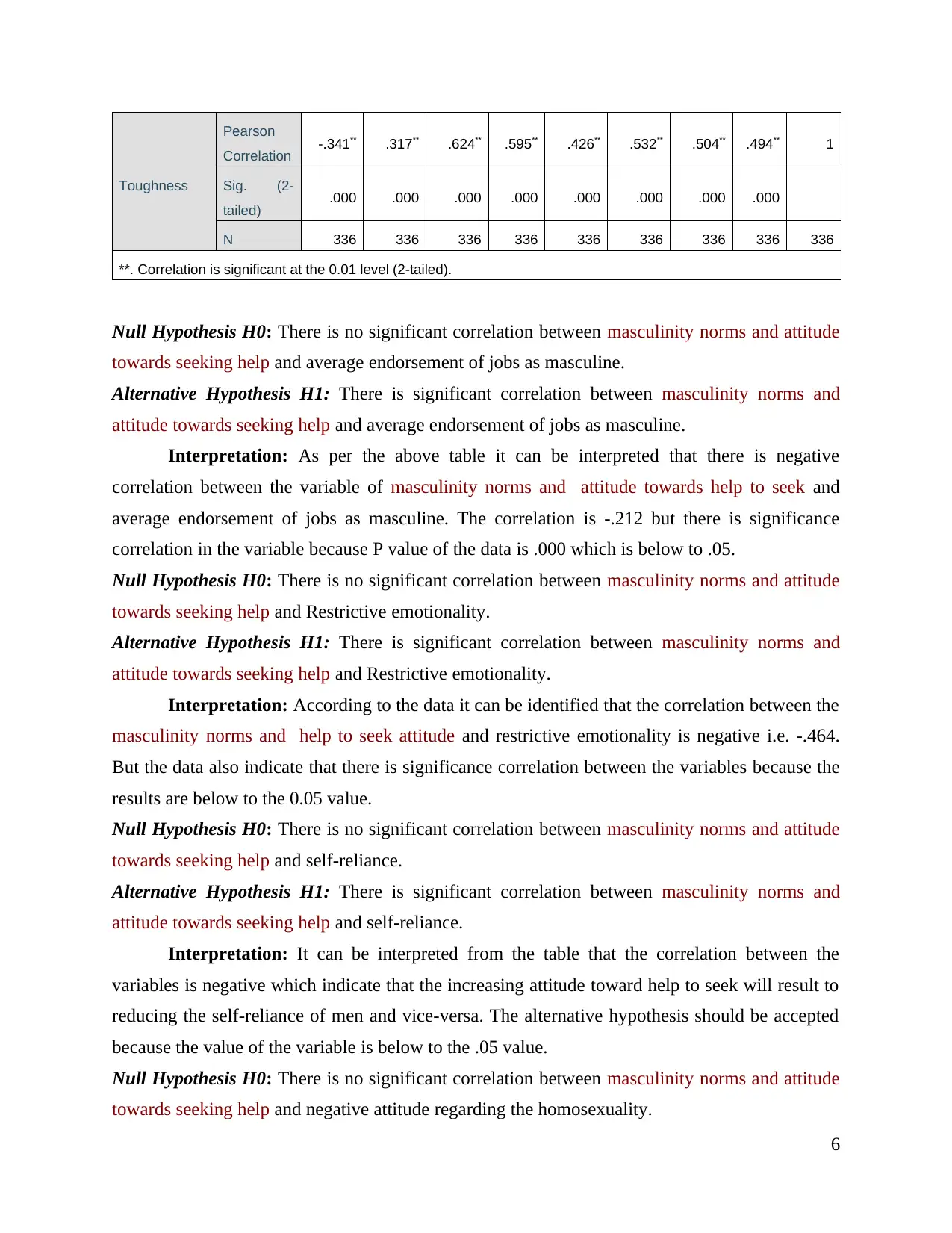
Toughness
Pearson
Correlation -.341** .317** .624** .595** .426** .532** .504** .494** 1
Sig. (2-
tailed) .000 .000 .000 .000 .000 .000 .000 .000
N 336 336 336 336 336 336 336 336 336
**. Correlation is significant at the 0.01 level (2-tailed).
Null Hypothesis H0: There is no significant correlation between masculinity norms and attitude
towards seeking help and average endorsement of jobs as masculine.
Alternative Hypothesis H1: There is significant correlation between masculinity norms and
attitude towards seeking help and average endorsement of jobs as masculine.
Interpretation: As per the above table it can be interpreted that there is negative
correlation between the variable of masculinity norms and attitude towards help to seek and
average endorsement of jobs as masculine. The correlation is -.212 but there is significance
correlation in the variable because P value of the data is .000 which is below to .05.
Null Hypothesis H0: There is no significant correlation between masculinity norms and attitude
towards seeking help and Restrictive emotionality.
Alternative Hypothesis H1: There is significant correlation between masculinity norms and
attitude towards seeking help and Restrictive emotionality.
Interpretation: According to the data it can be identified that the correlation between the
masculinity norms and help to seek attitude and restrictive emotionality is negative i.e. -.464.
But the data also indicate that there is significance correlation between the variables because the
results are below to the 0.05 value.
Null Hypothesis H0: There is no significant correlation between masculinity norms and attitude
towards seeking help and self-reliance.
Alternative Hypothesis H1: There is significant correlation between masculinity norms and
attitude towards seeking help and self-reliance.
Interpretation: It can be interpreted from the table that the correlation between the
variables is negative which indicate that the increasing attitude toward help to seek will result to
reducing the self-reliance of men and vice-versa. The alternative hypothesis should be accepted
because the value of the variable is below to the .05 value.
Null Hypothesis H0: There is no significant correlation between masculinity norms and attitude
towards seeking help and negative attitude regarding the homosexuality.
6
Pearson
Correlation -.341** .317** .624** .595** .426** .532** .504** .494** 1
Sig. (2-
tailed) .000 .000 .000 .000 .000 .000 .000 .000
N 336 336 336 336 336 336 336 336 336
**. Correlation is significant at the 0.01 level (2-tailed).
Null Hypothesis H0: There is no significant correlation between masculinity norms and attitude
towards seeking help and average endorsement of jobs as masculine.
Alternative Hypothesis H1: There is significant correlation between masculinity norms and
attitude towards seeking help and average endorsement of jobs as masculine.
Interpretation: As per the above table it can be interpreted that there is negative
correlation between the variable of masculinity norms and attitude towards help to seek and
average endorsement of jobs as masculine. The correlation is -.212 but there is significance
correlation in the variable because P value of the data is .000 which is below to .05.
Null Hypothesis H0: There is no significant correlation between masculinity norms and attitude
towards seeking help and Restrictive emotionality.
Alternative Hypothesis H1: There is significant correlation between masculinity norms and
attitude towards seeking help and Restrictive emotionality.
Interpretation: According to the data it can be identified that the correlation between the
masculinity norms and help to seek attitude and restrictive emotionality is negative i.e. -.464.
But the data also indicate that there is significance correlation between the variables because the
results are below to the 0.05 value.
Null Hypothesis H0: There is no significant correlation between masculinity norms and attitude
towards seeking help and self-reliance.
Alternative Hypothesis H1: There is significant correlation between masculinity norms and
attitude towards seeking help and self-reliance.
Interpretation: It can be interpreted from the table that the correlation between the
variables is negative which indicate that the increasing attitude toward help to seek will result to
reducing the self-reliance of men and vice-versa. The alternative hypothesis should be accepted
because the value of the variable is below to the .05 value.
Null Hypothesis H0: There is no significant correlation between masculinity norms and attitude
towards seeking help and negative attitude regarding the homosexuality.
6
⊘ This is a preview!⊘
Do you want full access?
Subscribe today to unlock all pages.

Trusted by 1+ million students worldwide
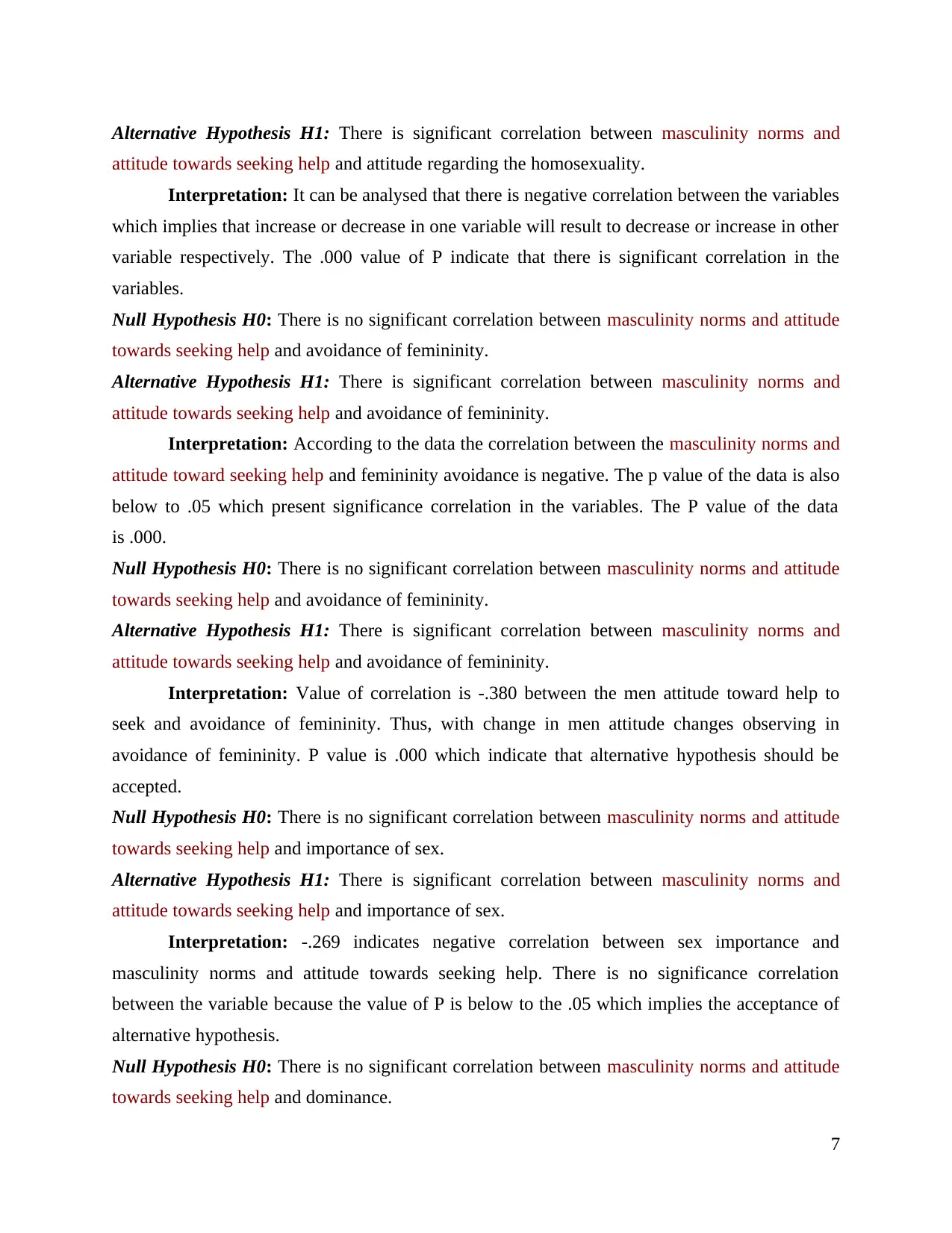
Alternative Hypothesis H1: There is significant correlation between masculinity norms and
attitude towards seeking help and attitude regarding the homosexuality.
Interpretation: It can be analysed that there is negative correlation between the variables
which implies that increase or decrease in one variable will result to decrease or increase in other
variable respectively. The .000 value of P indicate that there is significant correlation in the
variables.
Null Hypothesis H0: There is no significant correlation between masculinity norms and attitude
towards seeking help and avoidance of femininity.
Alternative Hypothesis H1: There is significant correlation between masculinity norms and
attitude towards seeking help and avoidance of femininity.
Interpretation: According to the data the correlation between the masculinity norms and
attitude toward seeking help and femininity avoidance is negative. The p value of the data is also
below to .05 which present significance correlation in the variables. The P value of the data
is .000.
Null Hypothesis H0: There is no significant correlation between masculinity norms and attitude
towards seeking help and avoidance of femininity.
Alternative Hypothesis H1: There is significant correlation between masculinity norms and
attitude towards seeking help and avoidance of femininity.
Interpretation: Value of correlation is -.380 between the men attitude toward help to
seek and avoidance of femininity. Thus, with change in men attitude changes observing in
avoidance of femininity. P value is .000 which indicate that alternative hypothesis should be
accepted.
Null Hypothesis H0: There is no significant correlation between masculinity norms and attitude
towards seeking help and importance of sex.
Alternative Hypothesis H1: There is significant correlation between masculinity norms and
attitude towards seeking help and importance of sex.
Interpretation: -.269 indicates negative correlation between sex importance and
masculinity norms and attitude towards seeking help. There is no significance correlation
between the variable because the value of P is below to the .05 which implies the acceptance of
alternative hypothesis.
Null Hypothesis H0: There is no significant correlation between masculinity norms and attitude
towards seeking help and dominance.
7
attitude towards seeking help and attitude regarding the homosexuality.
Interpretation: It can be analysed that there is negative correlation between the variables
which implies that increase or decrease in one variable will result to decrease or increase in other
variable respectively. The .000 value of P indicate that there is significant correlation in the
variables.
Null Hypothesis H0: There is no significant correlation between masculinity norms and attitude
towards seeking help and avoidance of femininity.
Alternative Hypothesis H1: There is significant correlation between masculinity norms and
attitude towards seeking help and avoidance of femininity.
Interpretation: According to the data the correlation between the masculinity norms and
attitude toward seeking help and femininity avoidance is negative. The p value of the data is also
below to .05 which present significance correlation in the variables. The P value of the data
is .000.
Null Hypothesis H0: There is no significant correlation between masculinity norms and attitude
towards seeking help and avoidance of femininity.
Alternative Hypothesis H1: There is significant correlation between masculinity norms and
attitude towards seeking help and avoidance of femininity.
Interpretation: Value of correlation is -.380 between the men attitude toward help to
seek and avoidance of femininity. Thus, with change in men attitude changes observing in
avoidance of femininity. P value is .000 which indicate that alternative hypothesis should be
accepted.
Null Hypothesis H0: There is no significant correlation between masculinity norms and attitude
towards seeking help and importance of sex.
Alternative Hypothesis H1: There is significant correlation between masculinity norms and
attitude towards seeking help and importance of sex.
Interpretation: -.269 indicates negative correlation between sex importance and
masculinity norms and attitude towards seeking help. There is no significance correlation
between the variable because the value of P is below to the .05 which implies the acceptance of
alternative hypothesis.
Null Hypothesis H0: There is no significant correlation between masculinity norms and attitude
towards seeking help and dominance.
7
Paraphrase This Document
Need a fresh take? Get an instant paraphrase of this document with our AI Paraphraser
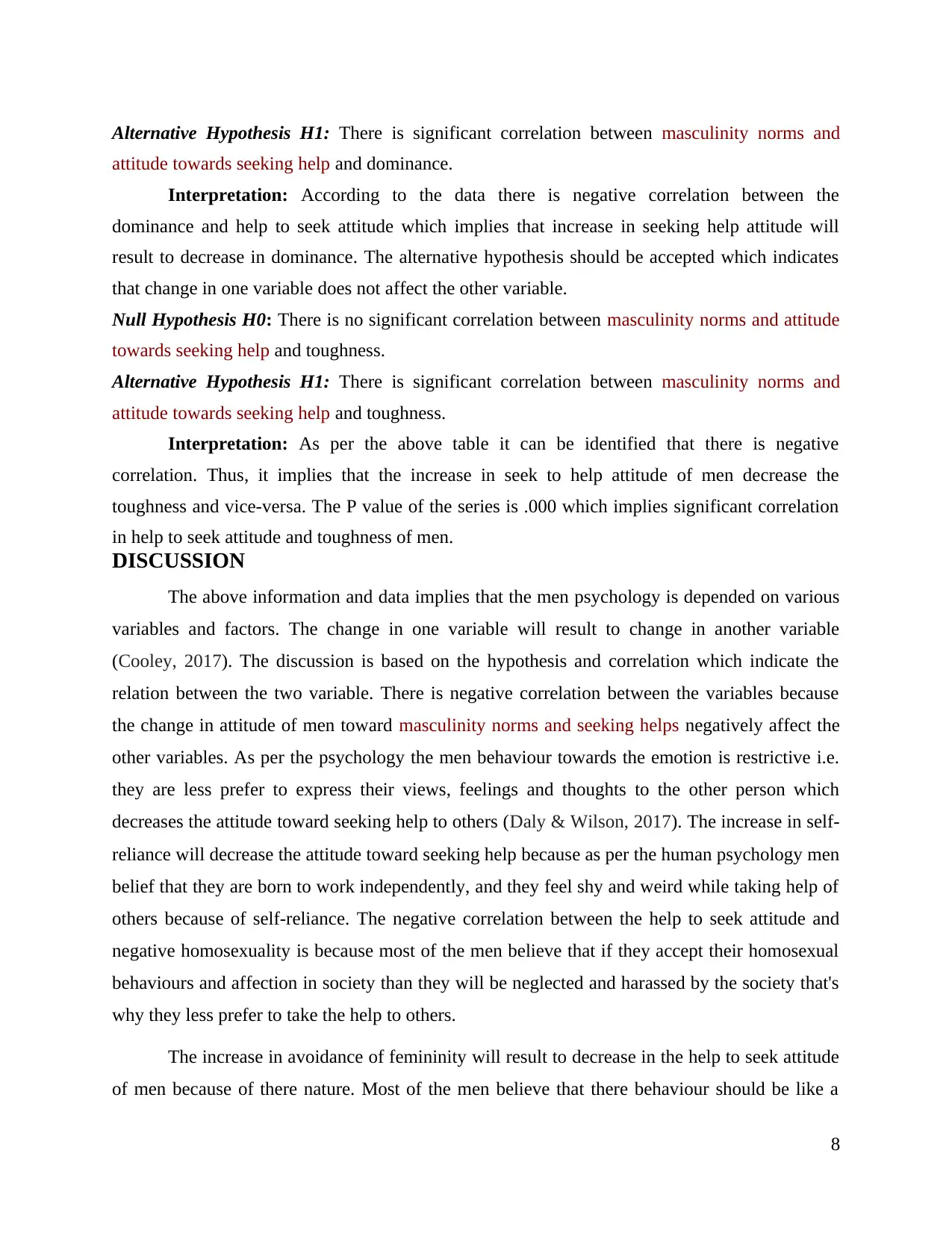
Alternative Hypothesis H1: There is significant correlation between masculinity norms and
attitude towards seeking help and dominance.
Interpretation: According to the data there is negative correlation between the
dominance and help to seek attitude which implies that increase in seeking help attitude will
result to decrease in dominance. The alternative hypothesis should be accepted which indicates
that change in one variable does not affect the other variable.
Null Hypothesis H0: There is no significant correlation between masculinity norms and attitude
towards seeking help and toughness.
Alternative Hypothesis H1: There is significant correlation between masculinity norms and
attitude towards seeking help and toughness.
Interpretation: As per the above table it can be identified that there is negative
correlation. Thus, it implies that the increase in seek to help attitude of men decrease the
toughness and vice-versa. The P value of the series is .000 which implies significant correlation
in help to seek attitude and toughness of men.
DISCUSSION
The above information and data implies that the men psychology is depended on various
variables and factors. The change in one variable will result to change in another variable
(Cooley, 2017). The discussion is based on the hypothesis and correlation which indicate the
relation between the two variable. There is negative correlation between the variables because
the change in attitude of men toward masculinity norms and seeking helps negatively affect the
other variables. As per the psychology the men behaviour towards the emotion is restrictive i.e.
they are less prefer to express their views, feelings and thoughts to the other person which
decreases the attitude toward seeking help to others (Daly & Wilson, 2017). The increase in self-
reliance will decrease the attitude toward seeking help because as per the human psychology men
belief that they are born to work independently, and they feel shy and weird while taking help of
others because of self-reliance. The negative correlation between the help to seek attitude and
negative homosexuality is because most of the men believe that if they accept their homosexual
behaviours and affection in society than they will be neglected and harassed by the society that's
why they less prefer to take the help to others.
The increase in avoidance of femininity will result to decrease in the help to seek attitude
of men because of there nature. Most of the men believe that there behaviour should be like a
8
attitude towards seeking help and dominance.
Interpretation: According to the data there is negative correlation between the
dominance and help to seek attitude which implies that increase in seeking help attitude will
result to decrease in dominance. The alternative hypothesis should be accepted which indicates
that change in one variable does not affect the other variable.
Null Hypothesis H0: There is no significant correlation between masculinity norms and attitude
towards seeking help and toughness.
Alternative Hypothesis H1: There is significant correlation between masculinity norms and
attitude towards seeking help and toughness.
Interpretation: As per the above table it can be identified that there is negative
correlation. Thus, it implies that the increase in seek to help attitude of men decrease the
toughness and vice-versa. The P value of the series is .000 which implies significant correlation
in help to seek attitude and toughness of men.
DISCUSSION
The above information and data implies that the men psychology is depended on various
variables and factors. The change in one variable will result to change in another variable
(Cooley, 2017). The discussion is based on the hypothesis and correlation which indicate the
relation between the two variable. There is negative correlation between the variables because
the change in attitude of men toward masculinity norms and seeking helps negatively affect the
other variables. As per the psychology the men behaviour towards the emotion is restrictive i.e.
they are less prefer to express their views, feelings and thoughts to the other person which
decreases the attitude toward seeking help to others (Daly & Wilson, 2017). The increase in self-
reliance will decrease the attitude toward seeking help because as per the human psychology men
belief that they are born to work independently, and they feel shy and weird while taking help of
others because of self-reliance. The negative correlation between the help to seek attitude and
negative homosexuality is because most of the men believe that if they accept their homosexual
behaviours and affection in society than they will be neglected and harassed by the society that's
why they less prefer to take the help to others.
The increase in avoidance of femininity will result to decrease in the help to seek attitude
of men because of there nature. Most of the men believe that there behaviour should be like a
8
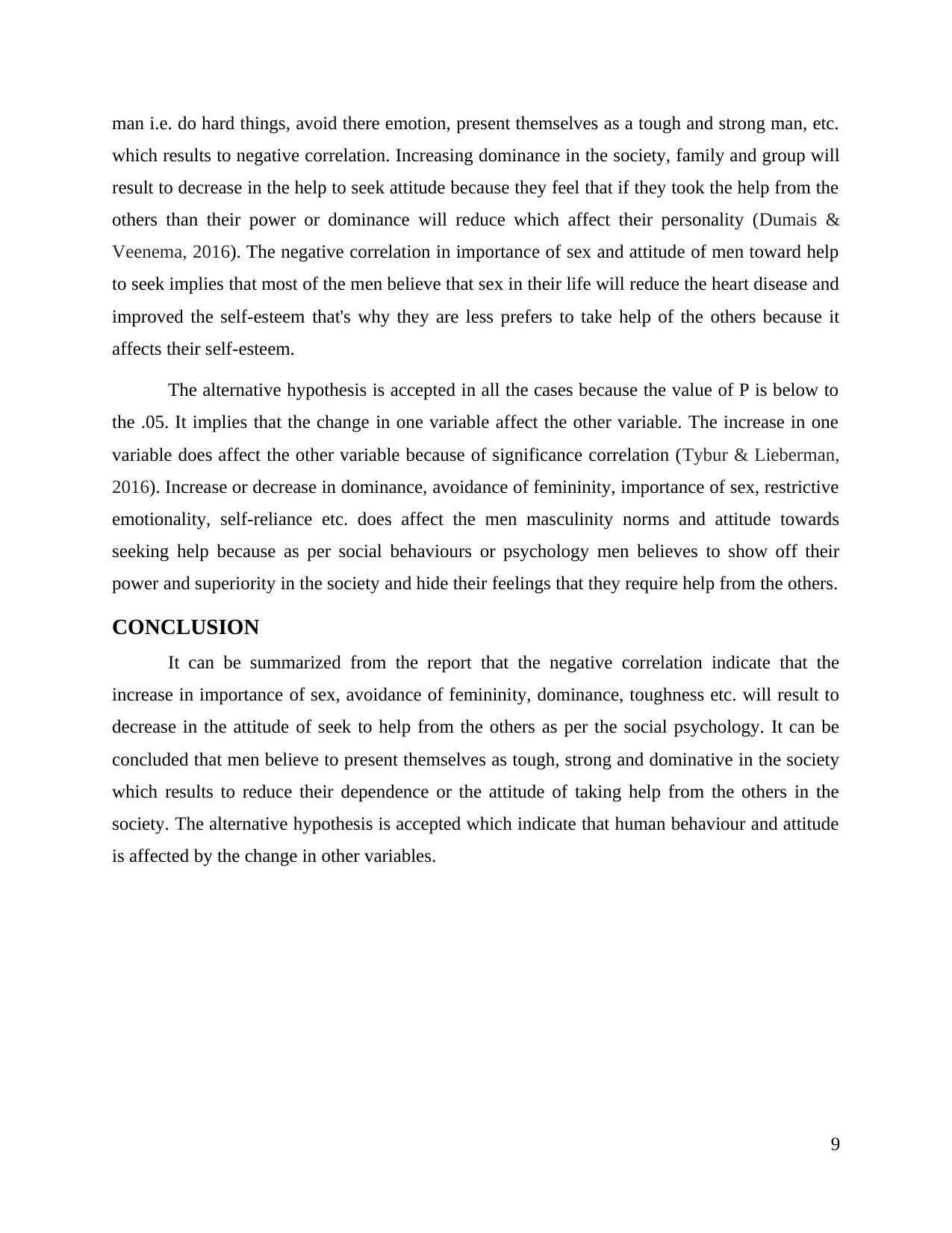
man i.e. do hard things, avoid there emotion, present themselves as a tough and strong man, etc.
which results to negative correlation. Increasing dominance in the society, family and group will
result to decrease in the help to seek attitude because they feel that if they took the help from the
others than their power or dominance will reduce which affect their personality (Dumais &
Veenema, 2016). The negative correlation in importance of sex and attitude of men toward help
to seek implies that most of the men believe that sex in their life will reduce the heart disease and
improved the self-esteem that's why they are less prefers to take help of the others because it
affects their self-esteem.
The alternative hypothesis is accepted in all the cases because the value of P is below to
the .05. It implies that the change in one variable affect the other variable. The increase in one
variable does affect the other variable because of significance correlation (Tybur & Lieberman,
2016). Increase or decrease in dominance, avoidance of femininity, importance of sex, restrictive
emotionality, self-reliance etc. does affect the men masculinity norms and attitude towards
seeking help because as per social behaviours or psychology men believes to show off their
power and superiority in the society and hide their feelings that they require help from the others.
CONCLUSION
It can be summarized from the report that the negative correlation indicate that the
increase in importance of sex, avoidance of femininity, dominance, toughness etc. will result to
decrease in the attitude of seek to help from the others as per the social psychology. It can be
concluded that men believe to present themselves as tough, strong and dominative in the society
which results to reduce their dependence or the attitude of taking help from the others in the
society. The alternative hypothesis is accepted which indicate that human behaviour and attitude
is affected by the change in other variables.
9
which results to negative correlation. Increasing dominance in the society, family and group will
result to decrease in the help to seek attitude because they feel that if they took the help from the
others than their power or dominance will reduce which affect their personality (Dumais &
Veenema, 2016). The negative correlation in importance of sex and attitude of men toward help
to seek implies that most of the men believe that sex in their life will reduce the heart disease and
improved the self-esteem that's why they are less prefers to take help of the others because it
affects their self-esteem.
The alternative hypothesis is accepted in all the cases because the value of P is below to
the .05. It implies that the change in one variable affect the other variable. The increase in one
variable does affect the other variable because of significance correlation (Tybur & Lieberman,
2016). Increase or decrease in dominance, avoidance of femininity, importance of sex, restrictive
emotionality, self-reliance etc. does affect the men masculinity norms and attitude towards
seeking help because as per social behaviours or psychology men believes to show off their
power and superiority in the society and hide their feelings that they require help from the others.
CONCLUSION
It can be summarized from the report that the negative correlation indicate that the
increase in importance of sex, avoidance of femininity, dominance, toughness etc. will result to
decrease in the attitude of seek to help from the others as per the social psychology. It can be
concluded that men believe to present themselves as tough, strong and dominative in the society
which results to reduce their dependence or the attitude of taking help from the others in the
society. The alternative hypothesis is accepted which indicate that human behaviour and attitude
is affected by the change in other variables.
9
⊘ This is a preview!⊘
Do you want full access?
Subscribe today to unlock all pages.

Trusted by 1+ million students worldwide
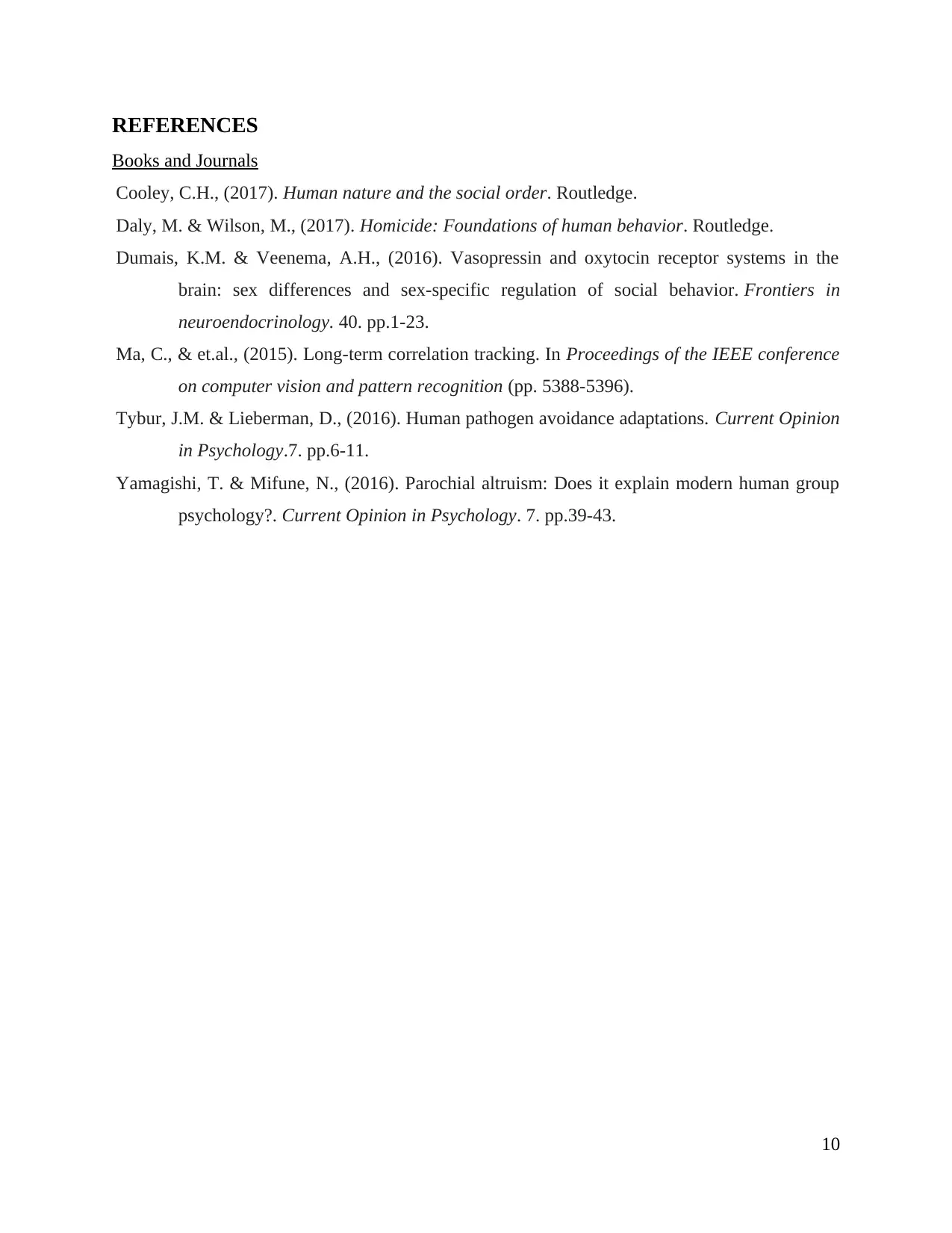
REFERENCES
Books and Journals
Cooley, C.H., (2017). Human nature and the social order. Routledge.
Daly, M. & Wilson, M., (2017). Homicide: Foundations of human behavior. Routledge.
Dumais, K.M. & Veenema, A.H., (2016). Vasopressin and oxytocin receptor systems in the
brain: sex differences and sex-specific regulation of social behavior. Frontiers in
neuroendocrinology. 40. pp.1-23.
Ma, C., & et.al., (2015). Long-term correlation tracking. In Proceedings of the IEEE conference
on computer vision and pattern recognition (pp. 5388-5396).
Tybur, J.M. & Lieberman, D., (2016). Human pathogen avoidance adaptations. Current Opinion
in Psychology.7. pp.6-11.
Yamagishi, T. & Mifune, N., (2016). Parochial altruism: Does it explain modern human group
psychology?. Current Opinion in Psychology. 7. pp.39-43.
10
Books and Journals
Cooley, C.H., (2017). Human nature and the social order. Routledge.
Daly, M. & Wilson, M., (2017). Homicide: Foundations of human behavior. Routledge.
Dumais, K.M. & Veenema, A.H., (2016). Vasopressin and oxytocin receptor systems in the
brain: sex differences and sex-specific regulation of social behavior. Frontiers in
neuroendocrinology. 40. pp.1-23.
Ma, C., & et.al., (2015). Long-term correlation tracking. In Proceedings of the IEEE conference
on computer vision and pattern recognition (pp. 5388-5396).
Tybur, J.M. & Lieberman, D., (2016). Human pathogen avoidance adaptations. Current Opinion
in Psychology.7. pp.6-11.
Yamagishi, T. & Mifune, N., (2016). Parochial altruism: Does it explain modern human group
psychology?. Current Opinion in Psychology. 7. pp.39-43.
10
Paraphrase This Document
Need a fresh take? Get an instant paraphrase of this document with our AI Paraphraser

11

12
⊘ This is a preview!⊘
Do you want full access?
Subscribe today to unlock all pages.

Trusted by 1+ million students worldwide
1 out of 12
Your All-in-One AI-Powered Toolkit for Academic Success.
+13062052269
info@desklib.com
Available 24*7 on WhatsApp / Email
![[object Object]](/_next/static/media/star-bottom.7253800d.svg)
Unlock your academic potential
Copyright © 2020–2025 A2Z Services. All Rights Reserved. Developed and managed by ZUCOL.